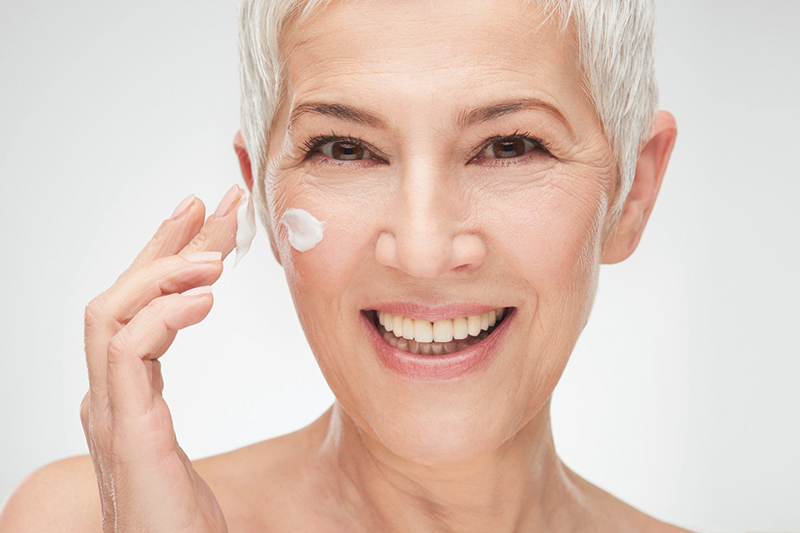If you think this is just another article about skin care…think again!
Hundreds of articles are written every year about anti-aging skin care and what happens when you apply a skin cream. Most articles are either so vague or so scientific that you wonder why you wasted your time reading them.
Although the skin rejuvenation process is very scientific, I will break it down for you so you will never forget how your skin’s rejuvenation process works – you will have an a-ha moment!
Under a microscope, the rejuvenation process is absolutely amazing. What causes aging skin to rejuvenate? How does it work? Or does it?
Take a look at the image of the skin below. The epidermis as a whole contains five layers of skin. As you can see, the top surface layer is called the stratum corneum and goes five layers down. The bottom layer is called the basal cell layer; this is the deepest portion of the epidermis.

Here Comes the Analogy…
Deep inside your epidermis are cells and fatty lipids. This is considered the brick-and-mortar/concrete of your skin. The fatty lipids are the (mortar/concrete) that hold the cells (the bricks) together. It creates skin that is strong, hydrated, and soft. It has the natural moisturizers in and keeps bacteria and environmental chemicals out.
The stronger the brick-and-mortar, the healthier your skin can look. Your skin can look tighter, which means less noticeable wrinkles, less sagging skin, and so on. However, as you age, your skin takes a beating, just like the brick wall, damaging the mortar and loosening the bricks. When you look in the mirror, you notice things are breaking up, cracking, and falling apart.

Of course, aging causes your skin to break down, along with exposure to UV radiation, pollution, gravity, and chemical creams. You can see how a very old brick wall looks compared to a professionally repaired one. It takes some time, but there is a huge difference, right?
But what specifically has to happen on a scientific level to repair skin? For an anti-aging skin cream to penetrate deep, interact with your cells, and begin to rebuild the critical brick and mortar of your skin, it must be able to penetrate the layers of the epidermis with powerful nutrients coming from carefully selected ingredients.
How Can This Be Accomplished?
You must have specific, nutrient-dense, botanical compounds with low molecular weight (tiny molecules). The molecules of these oils and compounds must be smaller than skin molecules to penetrate the skin deeply.
It’s all about the Dalton…. But what is a Dalton?
A Dalton is a scientific unit for molecular weight used to measure the size of molecules in skincare ingredients. The rule says that only tiny molecules, less than 500 Daltons, are able to penetrate healthy skin deeply. However, according to Dr. J of medically-no-nonsense, “Most ingredients in cosmetics cannot penetrate the skin. Manufacturers need to consider the 500-Dalton rule. It is futile to spend so much money on manufacturing a product if one does not keep in mind its effectiveness in penetrating the layers of the skin.”
Many skin cream companies ignore the 500-Dalton rule, and the so-called “cream” just sits on top of your skin. That would be like painting a brick wall to avoid repairing it. Nothing substantial gets accomplished, and the brick and mortar just gets weaker and weaker. Deceptive marketing makes you think you’re buying a great product. Be careful!
Unfortunately, many companies have found a way to make chemicals penetrate your skin by using ethanol, which increases the risk of causing skin irritation and dryness. How ironic. It’s important to check your labels!
Formulating a true anti-aging skin cream is no easy task. The selected ingredients must be from potent organic sources. They must molecularly penetrate deep and interact with your skin’s epidermal cellular network, providing the necessary proteins and critical nutrients to create healthy, strong cells (bricks) and healthy, strong lipids (mortar/cement). Then, and only then, can you expect optimal skin rejuvenation and skin cream you know is working and can comfortably invest in.
Castor Oil? Really?
An example of a compound/oil that not only penetrates deep into the layers of your skin but can also pull all the ingredients associated with it deep into your skin is a particular type of castor oil. It’s not the same castor oil sweet ole grandma used, though – this particular castor oil was discovered and researched by a naturopathic doctor who has used it clinically since 2007.
The immense skin-penetrating power of this castor oil cannot be overstated. After a lengthy discussion with this naturopathic doctor, I decided to use this castor oil in my Immortal Opulence Anti-Aging Skin Cream, which includes twenty-eight rare ingredients, to achieve that deep skin penetration needed to achieve optimal skin rejuvenation. Hopefully, you now have a better understanding of how the “right” skin cream works to rebuild, repair, and optimize your skin to youthful levels. And since you’re already here, why not take a quick look? Visit www.MyImmortalOpulence.com.
Richard Fanelli is a relentless anti-aging researcher and professionally trained skin care formulator. His anti-aging skin cream, Immortal Opulence, was awarded best-in-category two years in a row by Natural Nutmeg readers. He resides in Connecticut.
Visit: www.MyImmortalOpulence.com to learn more.
